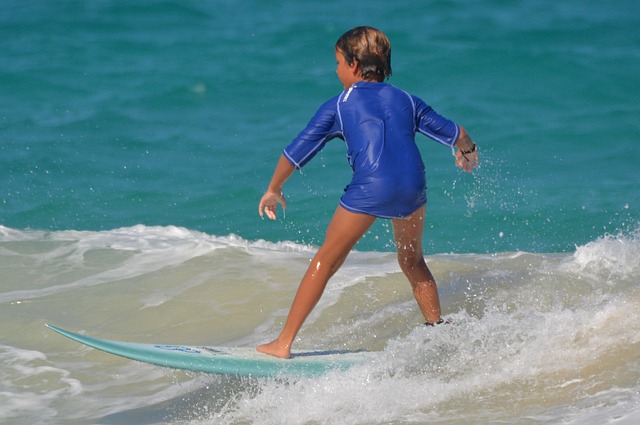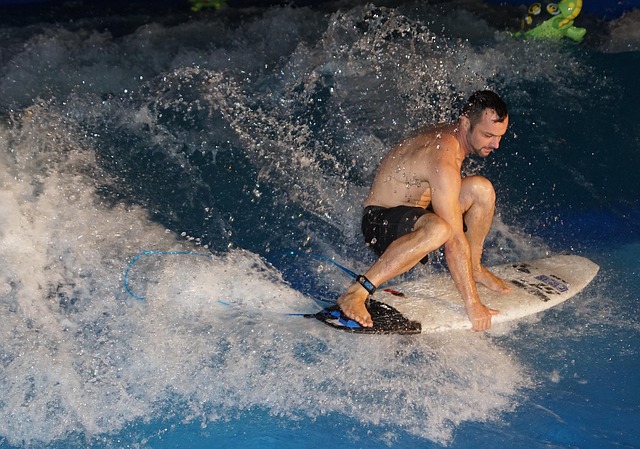For beginner wave riders, understanding classic design is paramount when choosing their first surfboard. These boards offer stability, ease of paddling, and a forgiving nature ideal for learning balancing and catching waves. With a longer nose, fuller outline, and symmetrical shape, they cut through water effortlessly, allowing newcomers to focus on refining their technique. Classic designs are versatile for smaller waves and provide a solid foundation for future learning, making them a top choice for surfboard novices seeking an authentic surfing experience.
Introducing our comprehensive guide on classic design for wave riding, tailored for aspiring surfers. In this article, we demystify the foundation of surfing with a classic surfboard, offering a step-by-step journey from understanding its design principles to choosing the perfect size and mastering techniques.
Discover the benefits of a classic board for beginners, explore key features, and learn tips to enhance your surfing experience. Whether you’re new to the ocean or seeking to improve, this guide provides valuable insights for navigating waves with confidence.
Understanding Classic Design: The Foundation for Beginners

Understanding classic design is a crucial foundation for any beginner wave rider looking to choose their first surfboard. These boards, characterized by their simplicity and timeless aesthetic, offer a different riding experience compared to modern alternatives. For novices, a classic surfboard provides a more stable platform, making it easier to learn the basics of balancing, paddling, and catching waves. The design typically features a longer nose, a fuller outline, and a symmetrical shape—all contributing to enhanced stability in the water.
The foundation of a classic design lies in its ability to cut through the water with minimal effort, allowing beginners to focus on refining their technique rather than fighting the board. These boards are versatile, suitable for smaller waves, and they often have a more forgiving nature, which is ideal for building confidence as a new surfer. When considering a surfboard for beginners, embracing classic design can set a solid precedent for future learning and provide an authentic surfing experience.
Benefits of a Surfboard for Starters: What to Expect

A surfboard for beginners is an excellent investment for anyone looking to dive into the world of wave riding. For starters, it offers a range of benefits that make learning to surf more accessible and enjoyable. First, most Surfboards designed for beginners are wider and longer, providing better stability and balance. This design allows new surfers to catch waves with ease, build confidence, and reduce the risk of falling.
Additionally, beginner-friendly surfboards often feature softer, more flexible foam cores and smaller fins, making them easier to maneuver and control. These features simplify the learning process, enabling newcomers to focus on mastering the basics like paddling, positioning, and standing up without getting bogged down by complex board dynamics. With the right surfboard for beginners, you can expect to have more fun, learn faster, and develop a lifelong passion for surfing.
Key Features of a Classic Surfboard

A classic surfboard, ideal for beginners looking to carve their path on waves, boasts several key features that make it both user-friendly and efficient. Firstly, its fuller shape provides more buoyancy, allowing newcomers to catch waves with ease and maintain stability while paddling out. This design also offers a smoother ride and easier turns, making it perfect for learning fundamental surfing techniques like carving and cutbacks.
Additionally, classic surfboards typically feature a single fin setup, which enhances their predictability and control. The single fin provides excellent up-and-down movement, enabling surfers to pump and maintain speed effectively. This stability is crucial for beginners who are still developing their balance and timing, making it a reliable choice for gaining confidence on the water.
Choosing the Right Size: A Step-by-Step Guide for Novices

Choosing the right size surfboard is a crucial first step for novice wave riders. It’s all about finding the balance between your body weight, skill level, and the type of waves you’ll be riding. Start by assessing your overall height and weight – generally, heavier individuals may prefer slightly longer boards for stability, while lighter surfers can opt for shorter boards that offer more maneuverability.
Next, consider your experience level. Beginners are often advised to stick with mid-length boards (typically 7-10 feet) as they provide a happy medium between control and speed. These versatile boards are designed to perform well across various wave conditions, making them ideal for learning the basics. As you gain confidence and skill, you can experiment with different sizes based on your preferred style of surfing – from shortboards for aggressive maneuvers to longer boards for cruising and catching more waves.
Setup and Positioning: Mastering Your Classic Board

Setting up and positioning yourself on a classic surfboard is an art in itself, especially for beginners looking to ride waves with confidence. The first step is to choose the right board; for newbies, a longer, fuller-shaped classic design can offer more stability and ease of paddling. Ensure your board is properly balanced by distributing your weight evenly across its length. Stand towards the tail end, keeping your feet shoulder-width apart, and position your hands on the deck just ahead of your chest for optimal control.
Remember, the key to successful riding is finding a comfortable stance that allows you to paddle efficiently and maintain balance while facing the nose of the board towards the shore break. This basic setup will provide a solid foundation as you learn to catch waves, ensuring you’re well-prepared to master the art of wave riding with your classic surfboard.
Techniques for Riding Waves with Classic Design

Riding waves with a classic surfboard design offers a unique and rewarding experience, especially for beginners looking to master the art of surfing. One of the key techniques is to maintain a relaxed and balanced stance, keeping your center of gravity low. This stability is crucial when facing larger waves, as it allows you to pump and carve more effectively. Beginners should focus on developing a fluid motion, utilizing their entire body to catch and harness the wave’s power.
A classic surfboard encourages a more traditional paddling style, where the rider uses long, smooth strokes to gain speed and position. This technique is beneficial for building endurance and learning to read the ocean’s rhythm. By combining these skills with the board’s classic design, surfers can enhance their overall performance, enabling them to catch more waves and enjoy a smoother, more controlled ride.
Tips and Tricks: Enhancing Your Surfing Experience

When it comes to enhancing your surfing experience, especially as a beginner, choosing the right surfboard is paramount. Opting for a board designed for beginners offers stability and ease of manoeuvre, allowing you to focus on perfecting your technique without feeling overwhelmed by the board’s performance. Look for boards that are typically shorter in length, wider across the deck, and have rounded edges—these features make them more buoyant and forgiving in choppy conditions.
Beyond board selection, mastering basic surfing techniques and understanding ocean conditions are key. Practice breaking waves consistently, aiming to catch them at their crests for maximum speed and control. Learn to read wave patterns and anticipate breaks, which can be improved by studying local surf spots and consulting experienced surfers or lifeguards. Always consider safety first, wearing appropriate gear like a leash that connects you to your board to prevent losing it in the water, and staying within your comfort zone, especially when tackling larger waves.
